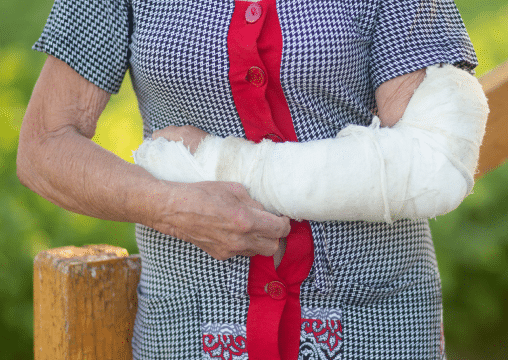Broken Bones in the Nursing Home
Broken bones are a common occurrence among elderly residents of nursing homes due to their fragile bones and risk of falls. However, some of these injuries are a result of neglect or abuse from caregivers. It is important for nursing homes to have proper protocols in place to prevent falls and monitor residents for any potential fractures.

Home ▸ Nursing Home Injuries ▸ Broken Bones
- Most Common Types of Broken Bones in Nursing Homes
- Statistics On Broken Bones in Nursing Homes
- Causes of Broken Bones in Nursing Homes
- Factors that Increase the Risk of Broken Bones
- Broken Bone Impact on Elderly Residents
- Are nursing homes responsible for broken bones in residents?
- Compensation for Broken Bone Victims In A Nursing Home
- Don’t Suffer in Silence
American nursing care facilities are currently home to at least 1.4 million seniors above the age of 65. These homes should be a safe haven for senior residents. However, cases of broken bones have become a widespread concern as more families report injuries within nursing homes.
Specific actions or inactions can lead to broken bones. For instance, lifting a patient improperly when moving them in or out of bed is the most common reason for recurrent broken bones. Failure to provide specific devices to support a patient when standing or moving into a wheelchair is another common cause of broken bones. Slip and falls frequently lead to broken bones as well.
Nurses and caregivers within nursing homes are obligated to ensure the wellbeing of patients. When cases of broken bones happen, it may be an indication of poor or even negligent caregiving.
Most Common Types of Broken Bones in Nursing Homes
Broken bones almost always lead to pain and limited mobility, and there are additional considerations as well. The supply of blood to human bones should be constant, but a broken bone may experience interruptions in its blood supply, leading to the death of bone tissue. Broken bones can also cause damage to surrounding tissues and organs. The situation is worse for seniors who may already have other underlying health-related concerns. The following are some common causes of broken bones:
Compression Fractures
Compression fractures, or spontaneously broken bones, affect the vertebrae, which are the bones of the spine. They often occur suddenly and may be hard to explain. These injuries can lead to pain and extreme discomfort. In the majority of cases, compression fractures are caused by osteoporosis. Other possible causes of compression fractures include spine-related injuries and tumors.
Seniors with osteoporosis need to use caution when moving the body because their bones are fragile and easily fractured. When performing certain motions, such as bending forward and backward, without proper care, they risk injury to their spine. Excess pressure on the vertebrae can easily lead to compression fractures. Unfortunately, most caregivers fail to realize the extent of damage they may be exposing seniors to and may fail to help ensure that their movements are within a healthy range.
Collarbone Fractures
Seniors sometimes end up injuring their collarbones in the case of a fall. They may fall from their bed, chair, or wheelchair, especially when left unattended for long hours. A severe collarbone fracture may require urgent surgery to minimize the risk of further incapacitation.
Stress Fractures
Stress fractures often emerge at critical joint areas such as ankles. Stress fractures often arise due to repetitive motion on parts of the body, such as overuse of feet during exercise or movement. These injuries have the potential to become more painful over time without immediate medical attention.
Many stress fractures emerge due to the lack of adequate care plans to treat spontaneously broken bones. Unless those working in nursing homes understand practical intervention measures, these injuries can easily lead to severe pain.
Ankle Fractures
Seniors living in nursing homes also have a high susceptibility to ankle fractures. Such injuries can occur in case of slips or sudden falls. The small bones around the heels feel the most significant pressure when slips occur. Additionally, ankle bones tend to be vulnerable to adverse complications from twisting during routine activities.
Statistics On Broken Bones in Nursing Homes
A recent report on the safety of seniors in nursing homes revealed that nursing home residents averaged 2.6 falls every year. Many of these falls cause severe injuries that require surgical procedures. Unfortunately, in 10 to 20% of cases involving injuries within nursing homes, the injury leads to a fatality. The report further revealed that more than 27% of accidents that lead to broken bones within nursing homes are due to underlying negligence, and that could also be a potential sign of abuse in the nursing home.

Causes of Broken Bones in Nursing Homes
Various situations may lead to broken bones for seniors living in nursing homes. Physical abuse is among these risks. While nursing homes should do everything possible to provide a safe living environment for seniors, the unfortunate truth is that cases of physical abuse in nursing homes leading to broken bones are prevalent.
Improper lifting, handling, and moving of seniors can contribute to broken bones as well. Sometimes, this may be an unconscious mistake without any harm intended. Indeed, human error is among the other most common issues that cause broken bones among seniors within nursing homes. Cluttered homes, wet surfaces, and other unsafe spaces within the nursing home can quickly become injury traps for seniors.
Another cause of recurrent broken bones is inadequate caregiving skills. Ideally, a care facility should equip a caregiver to handle seniors’ needs with exceptional caution. Seniors need support with basic activities of daily living. Unless these caregivers understand the delicate balance needed to help keep seniors safe, the recurrence of broken bones may be an inevitable outcome.
Factors that Increase the Risk of Broken Bones
The risk of broken bones tends to increase with age, and deteriorating health is also one of the most significant risk factors. Health issues that increase the risk of broken bones include chronic disorders such as rheumatoid arthritis, diabetes, or cancer. If your loved one has an existing condition, even minor physical trauma could lead to a broken bone.
Seniors with a history of smoking also have a greater risk of hip and foot fractures. Smoking has a lasting negative effect on the body. It affects bone mineral density and causes inconsistent degeneration of the bones. As such, seniors who smoke often stand a higher risk of dealing with recurrent fractures.
Alcohol use also presents a greater risk of broken bones. Chronic alcohol intake has the potential to accelerate the risk of low bone mass. If a senior living in a nursing home has a history of alcohol use, the risk of broken bones increases two-fold, more so if they experience physical abuse or mishandling.
Broken Bone Impact on Elderly Residents
Seniors may already be physically frail, which calls for additional care and attention. When these seniors experience broken bones, it can quickly start to affect other aspects of their lives. For instance, older adults who already depend on caregivers may find their independence further diminished by a broken bone, to the point where they struggle to achieve the most basic tasks.
Seniors who suffer broken bones may grapple with extreme pain, an outcome that can easily affect their mood and emotional wellbeing. Further, in the cases of broken bones caused by physical abuse, seniors may opt for seclusion. If you start to notice that your loved one has become distant, especially following an injury, it may indicate abuse.
Are nursing homes responsible for broken bones in residents?
Families take their loved ones to nursing homes with the anticipation of exceptional care. As such, nursing homes should have the primary objective of providing adequate care and minimizing the risk of injuries. These facilities must ensure that they hire qualified staff to oversee the welfare of the senior residents. In cases of negligence by unqualified staff, a nursing home may also be legally responsible for injuries that result.
Additionally, nursing homes are responsible for training staff on matters related to patient welfare. Therefore, nursing homes may also be legally liable in cases of broken bones caused by poorly-trained staff. At a personal level, however, caregivers take the responsibility of providing care based on their Hippocratic oath. If broken bones occur due to negligence at a personal level, such individuals may be legally responsible.
Compensation for Broken Bone Victims In A Nursing Home
You have the right to sue the nursing home in the case of broken bones caused by negligent care of a senior. Neglect during care in a long-term care facility is not a new phenomenon in the United States. Nursing home residents or their loved ones should move quickly to determine what legal options are available after a broken bone.
Broken femurs could lead to hospital bills as high as $175,000. As long as your nursing home lawyer can prove liability, it will then be possible to file for compensation. If your loved one suffers broken bones while in a nursing home, you should report it and contact a lawyer immediately.

Don’t Suffer in Silence
Nursing homes are obligated to provide care to senior citizens. Therefore, nursing homes should be responsible for seniors suffering from broken bones while in their care. If you or your elderly loved one has suffered an injury due to neglect or abuse while in a nursing home, you may be able to file a nursing home lawsuit for damages incurred.
- Last Modified April 29, 2023
- Editorial Guidelines
Dr. Patricia Shelton, MD

Education:
- University of Washington, Doctor of Medicine – MD. June 2008
- University of Washington, Bachelor of Science – BS, Jun 2003
Background:
Neuroscience and Medicine
Career:
- Dr. Shelton primarily writes content for health-related websites, but has also written test prep materials, white papers, published research articles, court documents, and more.
- Dr. Shelton teaches anatomy and physiology at the college level for the National Institutes of Health.
